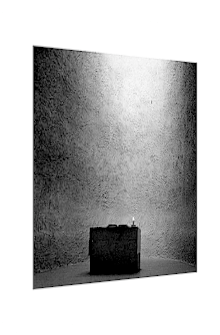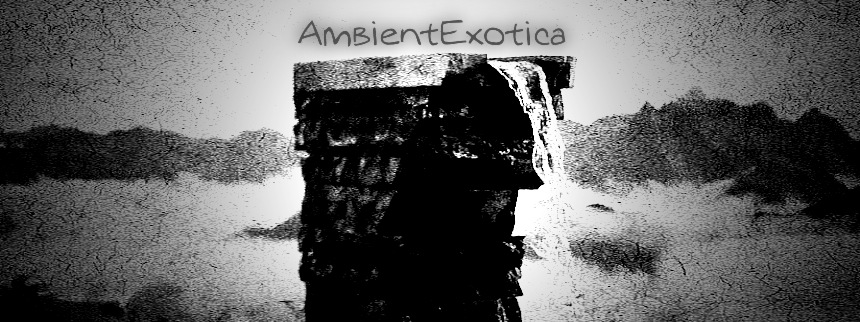
Valiska
La Tourette
2014
Granted, it has been done several times before, and today’s Ambient producers have either been inspired by the cinematic sepia aureoles of 1986’s The Name Of The Rose or the post-millennial, supposedly less valuable Angels And Demons, but whatever the source of inspiration may be, ecclesiastic crypts and churchly architecture impress the listener with their alkaline vestiges of pastoral sermons and wads of frankincense smoke simmering around a Gothic choir. Enter Calgary’s multi-instrumentalist and CJSW radio DJ Valiska aka Krzysztof Sujata and his destructionist take on French architecture: La Tourette is a short triptych of approximately ten minutes, self-released in July 2014 on Bandcamp in digital-only form. The artist demonstrates his love for architectural prowess – as happened previously in the saffron mirage Havana off the split release Digital Architecture (2013) – with the following description: Mass /Surface / Plan. What is that supposed to mean? Not that I have been let in on the secret, but it presumably describes the exterior surface and innermost rooms of the chapels Sainte Marie de La Tourette and Villeaceron, both of them looking entirely different, exuding modernist megalomania and shadows of a dubious past, at least when cross-linked to Valiska’s sound. Made of acoustic instruments such as cellos, guitars and pianos, the actual trademark and aesthetic achievement is found deep within and all around the clangs, rattles and studders that destruct the orderly Drone physiognomy, transforming the presumption of this being a Modern Classical artifact into an ignis fatuui adjacent to the Glitch genre. Sinister motifs, harmful melancholia… and crystalline resurrection? Let’s find out what the short trip to La Tourette has to offer.
The opener is called La Tourette (Chapel), serving as the seemingly self-explanatory gateway to the dichotomous synthesis between faux remembrances and astute reminiscences of increasingly chlorotic identikits. Even without having heard the first sound, the listener might anticipate the granuloma; it is clear in advance that Valiska’s layering technique is going to gyre between gravity and gravitas. Indeed, the mood is dense and almost mephitic, a potentially ribald remark amid the aura of a saints’ building. Asphyxiating cello or ebow sinews waft around an unexpectedly supernal glitter amalgamation, with echoey accordion remnants rounding off the arcane photometry. While the electro-acoustic textures are more akin to the Drone genre, their reverberated state makes them resemble a rather pointillistic-arpeggiated state. The careful emphasis on said reverb allows each surface’s afterglow to linger on and erect both the gustatory aura and erudite odor of this sanctuary… all done via the magic of sound waves, naturally! Placid movements, quiescent plinks, sudden eruptions of sparkling instruments that resemble clavi-, harpsi- but not necessarily vocal chords, the tone sequences and their interstitial alcoves breathe cinematic chromaticity, flashing lights and lilac shadows. Could this piece be based on sampled material? It seems incredibly senescent and clandestine.
The short centerpiece Villeaceron meanwhile clocks in at a mere 90 seconds but is closely tied to both movements that surround its complexion made of frequencies. The architecture of the real-world obelisk meanwhile resembles the jagged edges of a certain, most gruesome video game antagonist called Pyramid Head, but this is of no importance once the track is running on all cylinders. This is indeed an apt description, for Valiska takes the droning interlineal shapes and cauterizes them yet again with the help of fusillades of blotches and stop-and-go undercurrents, resulting in a hammering martelato arpeggio that is all the more bewildering in terms of the vitreous clarity of the argentine texture itself. Resembling a church organ entrapped by sputtering acidic guitar scythes, Villeaceron showcases Krzysztof Sujata’s proclivity for bending the nuts and bolts of a track by destroying the soothing equilibrioception. This titration process usually ends with a pH-value below 7, and this is the case here as well. Bubbling blebs, vesiculating specks… this second track delineates gigantomachy rather than theophany.
La Tourette (Rooms) is the endpoint of the journey, but definitely not the endgame. It is remarkable how awash with light the envisioned architecture of these rooms really is. Instead of harsh and recondite timbres, Sujata’s piano is in the foreground, strongly veiled in ligneous hall effects which flicker like sanguine flares. The constant oscillation is the agglutinating force of the presentation, interweaving both the black nonentity and the signs of life and clemency in the foreground. The piano is glacial at first, the harmonious overtones however spawn a reticulation of thankfulness, of genteel grace and a somewhat rhizomatic link to the nearby copses. Whereas the first two tracks were certainly grave and even sinister in their dualistic approach, La Tourette (Rooms) can be seen as the epiphany, the lactic syringa scenery that breaks the cannelure of the preceding material in order to blight the concept of Hauntology, Dark Ambient and whatnot. Naturally, this final piece does not bask in ethereal effulgence, but considering the intrinsic qualities and endemic demeanor of this EP, La Tourette (Rooms) is indeed the diaphanous rift to absorb the internecine burden and turn it into fibrillar delight.
Deconstruction is a formidable area in literature, film and music. Valiska’s La Tourette addresses the love for static noise protrusions, cataracts of jitters as well as aggrandized convulsions. Clocking in at a mere ten minutes, this little EP is quite a bit more emaciated than Krzysztof Sujata’s previous works, but shares many a resentment with the churchly halo that is built during the process of creation. Structure I off the artist’s EP called, well, Structure (2013) comes to mind tonality-wise; the textural variety and baseframe then showcase the fondness of an earthen approach made with real instruments. La Tourette features all of Valiska’s signature instruments, but with an important twist: the guitar seems to be out of focus this time. While clearly included, it is appearing in a much more processed state in order to make room for the piano. Whatever the source or instrumental base, the material is decorticated, harmed, sliced and cut. If this is what one is searching for, La Tourette’s stern and orderly architecture might come as a surprise once it reaches the cochlea of the aficionado.
Further listening:
- You can purchase and stream La Tourette at Bandcamp.
- Follow Valiska on Twitter: @TheValiska.
Ambient Review 362: Valiska – La Tourette (2014). Originally published on Jul. 23, 2014 at AmbientExotica.com.
